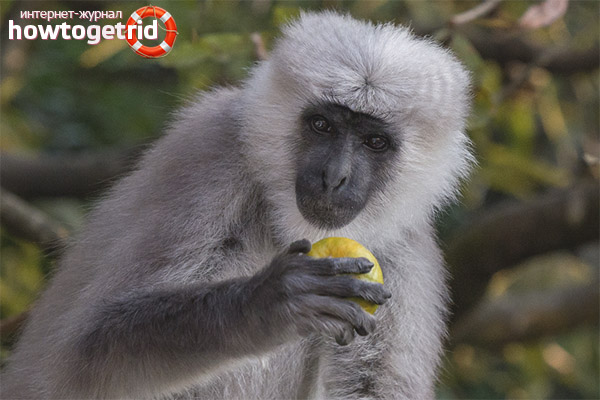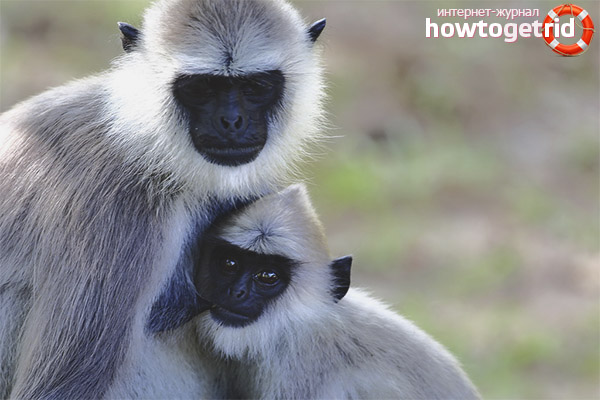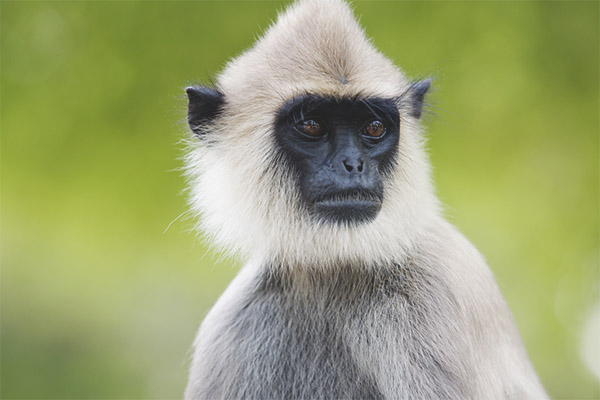The content of the article
The family of langurs belongs to the genus of monkeys, they include more than ten different species. In addition to such a name, these monkeys have another - thin-brow. In Hindi, the word "langur" has the meaning of "long tail", but to use this definition it is possible to correctly only one of the varieties of these monkeys - hanumana.
Description and habitat
Now the main territory inhabited by Langurs is considered to be India, where they are often monkeys at temples, as well as the island of Sri Lanka and Nepal.
One of the characteristic features of these animals is the three-chamber structure of the stomach. Depending on the size, small and medium langurs are distinguished. An adult monkey can reach a height of 45 and up to 80 centimeters, depending on the specific animal species.In addition, the tail of the langur itself often reaches a length of 1 meter.
The muzzle of a monkey is round, rather short in front, the eyes are close, and the nose does not protrude from the face. Usually, the tail and limbs of the langur are quite thin, and they are distinguished by strength and tenacity. In addition to sufficiently long legs, elongated fingers can be noted, among which only the first one is relatively shorter than the others.
In addition to growth, belonging to a particular species is determined by the color of the coat of the animal. It is for this reason that the description of the appearance of the langur can be considered generalized and collective. Mostly the fur of the langur is quite fluffy, monotonous, the shades on different parts of the body may slightly differ: the paws and the back area are darkish, while the belly is slightly lighter.
Some species of these monkeys have bright contrasting spots on their heads. Often you can find a Nemean langur, whose color is colorful and bright. The animal's muzzle is yellow, the head area is decorated with a clear brown stripe, and the tail has a white color. Again, for example, Javanese Langur may have a rich brown-red shade or ash-gray.
Langur also has rather long hair on its head, which is a characteristic external feature of this animal. Observing it from a distance or in photographs, it can be assumed that the crown looks like a crown on the head of a monkey or the hair looks like a comb.
Character traits and habits of the langur
Being a primate, Langur can easily move to enormous distances, while not going down to the surface of the earth. To do this, the monkey makes strong jumps, using branches for support.
If the branch that Langur has chosen for itself is located at some distance from it, the animal first begins to sway on the branch, using the power of its paws, and then makes a jump, whose length thus increases. When a monkey has to go down to the ground, it uses all four limbs for movement, resting on them.
In a natural habitat, you can meet a large flock of langurs, which includes up to 65 primates. Inside it, there will necessarily be a dominant male leader, as well as several ordinary langur males.
Among the other inhabitants of the pack are females, their young and teenagers. When langur grows up, he does not leave his company until he reaches puberty. As usual, each monkey has its own personal territory in its location, which it tremulously guards.
What eats Langur

It is worth paying attention to the fact that representatives of the breed of langurs almost never fall into the zoo. The reason for this is simple: this monkey is very fastidious in feeding, therefore, in conditions of keeping in an aviary, this animal is rather hard to feed. Being in a natural environment, the primate can easily find food for itself.
Due to the special structure of his stomach, Langur may for a long time try to find a new source of food for himself, but for this, he must first have a sufficiently dense meal.Thus, constantly moving and wandering through the forest, the primacy almost all the time is looking for food for itself, periodically stopping to rest.
In addition, it is not uncommon for a Langur or a whole pack of monkeys to visit separate settlements if they are located in close proximity to a wooded area. There they try to find food for themselves, if this could not be done in their usual habitat. And in most cases, the inhabitants of the settlements do not interfere with langurs to search for food in their gardens and yards, because this animal is considered to be sacred. Most residents of villages and villages even purposely keep some food near their homes.
Among the basic products that are eaten by langurs, you can select woody leaves, pieces of bark, various fruits and other fragments of forest vegetation that are suitable for food. In addition, will not disdain bird eggs or large insects. But, of course, the dessert for the langur are juicy and tasty fruits that they can find on their own territory.
The life span and reproduction of monkeys

Langurs, along with other varieties of monkeys that live in the pack, are tightly tied to their own young. Until the babies reach puberty, they continue to live with their own parents within the same monkey pack.
The appearance of babies into the world is not determined by specific time periods. In other words, the female can produce a baby in any season and month, but only once within a year and a half or two years. The ritual of mating games starts with the lure of a female that attracted her from her own flock.
She does it, being under the influence of hormones. Externally, the lure looks like a slight shake of his head in different directions. After the male consents to the courtship, the couple copulates. The act of mating itself may consist of a number of approaches.
The baby is born for about half a year, then the baby is born. In the exceptional majority of situations, the female langur produces one baby. Immediately after birth, a small langur firmly grasps mom's waist, which allows him to move with her.
Initially, the cub has a light color fur, which with the passage of time becomes darker. Unusually, with a small weight, which is equal to about half a kilogram, the body length of the young can reach as much as 20 cm.
During the first one and a half years of life, the monkey eats mother's milk, slowly moving to the food characteristic of an adult animal.
At the age of about a couple of years, a period of maturity begins, and then the monkey can leave its own flock. The maximum lifetime of a langur can reach as much as 31 years, but this happens very rarely.
Video: Langur (Presbytis)











To send